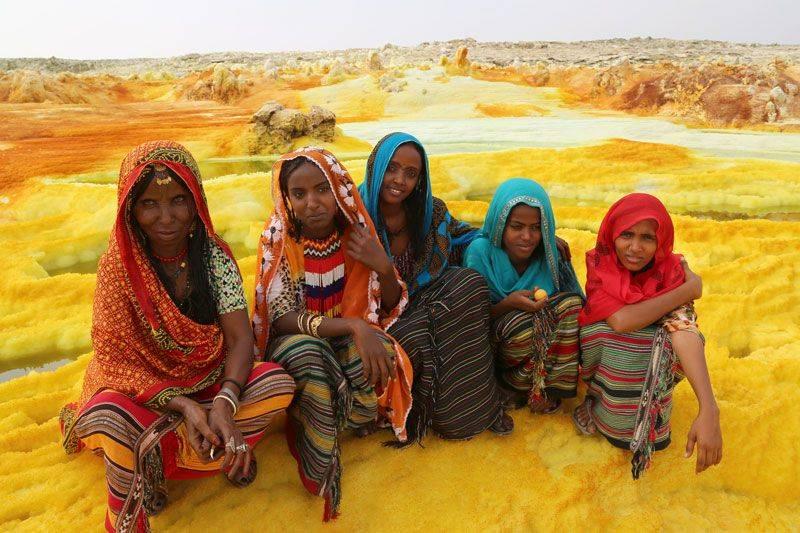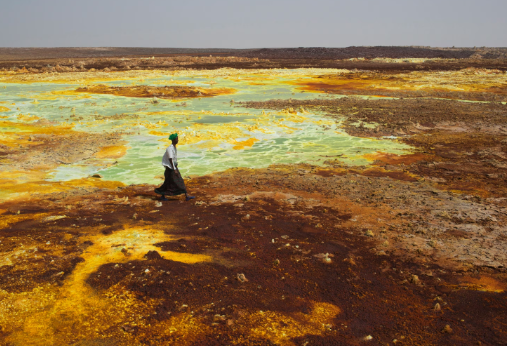If you’ve ever wondered where the hottest place on Earth is, look no further than Dallol in northern Ethiopia. This remote and desolate location experiences extreme temperatures, with an average temperature of 34°C (93°F) and peak temperatures of 46°C (115°F) during the summer months. What causes these scorching temperatures? Let’s delve into the unique atmospheric conditions of Dallol and their impact on local wildlife and communities. Share this article to learn more about why Dallol is considered the hottest place on Earth!

Dallol’s location at the lowest point of the Danakil Depression and over 300 days of sunshine each year contribute to its extreme climate. Additionally, the area receives almost no precipitation, making it one of the driest places on Earth. The unique atmosphere of Dallol is also shaped by its volcanic activity and geothermal springs, such as Dallol Volcano which still emits sulfuric gases today. These springs suggest that the area was once covered by an ancient lake or sea.
The World Meteorological Organization declared Dallol as “the hottest place on Earth” in 2013, with an average temperature of 34.4°C (94°F). Despite its inhospitable environment, people still reside in this isolated part of Ethiopia, surviving through livestock herding and salt mining from nearby salt flats.

Dallol, Ethiopia is a truly unique and extreme environment, unlike any other on Earth. It boasts some of the highest temperatures ever recorded, with an average maximum temperature of 97°F (36°C) and a record high of 94°F (34.4°C), making it hotter than Death Valley, California. The extreme temperatures are due to the location of Dallol in the lowest point of the Danakil Depression, combined with over 300 days of sunshine each year and very little precipitation.
The atmosphere of Dallol is also shaped by its volcanic activity and geothermal springs, such as the Dallol Volcano which last erupted in 1926. The area’s salt flats, lack of vegetation, and shade create a unique landscape that affects local wildlife and communities. The intense heat influences everything from the clothing people wear to how they manage their livestock herding and salt mining activities.
In this harsh environment, people must wear clothing that covers their skin completely to protect themselves from sunburn and heat stroke while working outdoors. They must also carefully plan their water usage, as water sources can be scarce during times of extreme heat. Despite the harsh conditions, people continue to live in this isolated part of Ethiopia, relying on livestock herding and salt mining as their main sources of livelihood.

Living in Dallol, Ethiopia poses a number of challenges for the locals due to the extreme weather conditions. The high temperatures, which can reach up to 97°F (36°C) on average, have a significant impact on farming activities, making it difficult for farmers to grow enough food for their families or livestock. To make a living, many rely on traditional methods such as herding livestock or mining salt. Despite these challenges, people continue to live in this isolated part of Ethiopia.
The unique atmosphere of Dallol is caused by a combination of factors, including volcanic activity, dry air, salt flats, lack of vegetation and shade. The volcanic activity produces heat from magma and geothermal springs, while the dry air traps heat, leading to higher temperatures. The salt flats absorb a lot of heat from the sun’s rays, making it even hotter than areas with less salt deposits. Additionally, the lack of vegetation and shade means that more sunlight is able to reach the ground during the day, further contributing to high temperatures.
Dallol’s location near the equator also contributes to its high temperatures. Low latitudes receive more energy from the sun, resulting in increased air temperature and evaporation rate. This makes it suitable for extreme heat conditions like those found in Dallol. Overall, the extreme climate of Dallol is a unique environment that has created a remarkable landscape unlike any other place on Earth.

In conclusion, the extreme temperatures in Dallol are a result of a combination of local features such as volcanic activity, lack of vegetation, and location near the equator. Situated in the Afar Triangle of northern Ethiopia, the area is characterized by an average air pressure that is significantly higher than anywhere else on Earth, leading to low relative humidity levels and frequent dust storms.
During summer, temperatures in Dallol can soar up to 46°C (115°F) due to strong solar radiation. Despite these extreme conditions, locals continue to live in the area and rely on traditional methods such as livestock herding and salt mining for their livelihoods. The unique environment of Dallol also presents an opportunity for scientific research into the adaptations of living organisms to harsh climates, as well as a popular destination for photographers seeking to capture its stunning landscapes and vibrant colors.
As research in the area continues, we may uncover even more secrets about this remarkable and extreme environment.

Living in an environment with extreme temperatures can have significant impacts on the local wildlife, vegetation, and communities. The high temperatures in Dallol, for instance, have led to a decrease in certain species of wildlife that are unable to survive in such conditions. Additionally, the scarcity of vegetation in the region is attributed to the difficulty for plants to grow and thrive in such an environment.
Humans living in the area face numerous health risks due to the extreme heat. These include heat exhaustion, dehydration, and sunburn from prolonged exposure to the hot climate. Farmers are also unable to cultivate crops, leading to food insecurity for those living in the region. Moreover, buildings and infrastructure can suffer long-term damage due to the intense temperatures.
The residents of Dallol depend on adapting to the environment or finding alternative sources of income such as livestock herding or salt mining near the salt flats. Protective clothing and regular hydration are essential for anyone visiting or living in this extreme environment. It is also crucial to be aware of potential health issues that could arise from spending too much time outdoors without adequate protection from the sun’s rays.
Despite the harshness of Dallol’s environment, it remains a place full of beauty and vibrant colors, making it a popular destination for photographers looking to capture unique landscapes on film or digital media. The intense climate of Dallol offers an opportunity for exploration into how humans can survive and adapt to challenging conditions – something that has been tested by locals for generations.
